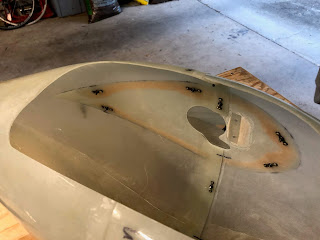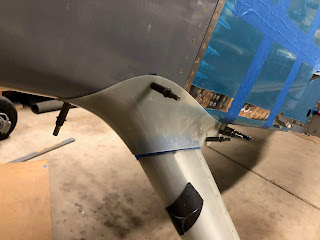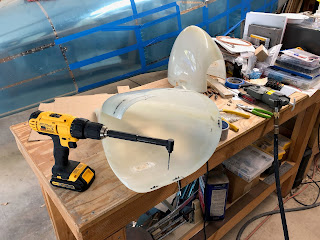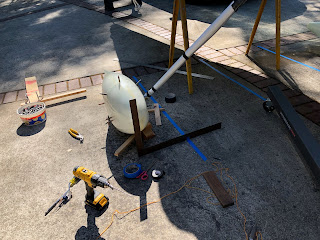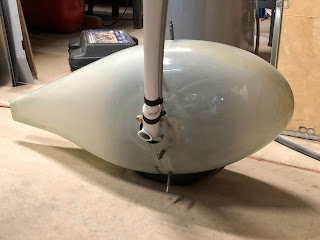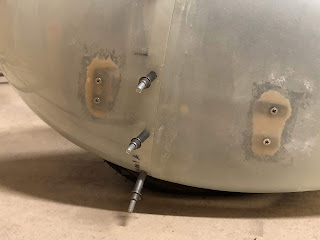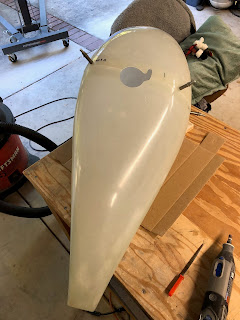Section: 46B
Hours: 5
After curing overnight, I separated the inside tab and shaped it with dremel tool, sand paper and file. Then I match drilled the tab to the fairing.
The tab is attached with 3 screws. Two of the screws will go into nut plates, but the innermost screw goes into a lock nut that gets embedded in flox/epoxy. Here I've just applied blobs of flox around the lock nuts.
A fillet must also be built up around the outside of the fairings to help hold them in place on the wheel pant (and for looks). First step is to scruff the outside of the wheel pant in the area where the fillet will be built.
Then I wrapped electrical tape around the edge of the fairing to prevent bonding and laid up a fillet of flox/epoxy. Flox epoxy is stronger than micro ballon putty. I think I will apply micro balloon later for final finishing because the flox it is difficult to smooth out perfectly.
Disclaimer: This blog is to provide others insight into my experience and for my own historical purposes. Airplane construction is a serious affair. I have no authoritative skills relating to airplane construction. As such, any use of the information contained on this blog is at your own risk.
Tuesday, October 23, 2018
Monday, October 22, 2018
Section: 46B
Hours: 4
The packing tape worked and I was able to separate the fairings from the wheel pants.
I cleaned up the edges of the flox fillets using the dremel tool with drum sander attachment. Then I roughed up the inside of one half and applied clear packing tape to the other half and laid up several layers of fiberglass to create an attachment tab for closing the rear of the fairing.
Hours: 4
The packing tape worked and I was able to separate the fairings from the wheel pants.
I cleaned up the edges of the flox fillets using the dremel tool with drum sander attachment. Then I roughed up the inside of one half and applied clear packing tape to the other half and laid up several layers of fiberglass to create an attachment tab for closing the rear of the fairing.
Sunday, October 21, 2018
Section: 46B
Hours: 4
I was able to back rivet the nut plates for the lower fairing attach points.
The plans call for a built up flox / epoxy fillet between the lower fairing and the wheel pants. I applied clear packing tape on the wheel pants in the fillet area to prevent bonding. Then I mixed up the flox and applied a bead around the fairing with wider areas around the attach points. The bead is slightly higher than the edge so that it will mash down when the fillet is attached to the wheel pant.
Here is what the fillet looks like after attaching to the wheel pant.
And a view from the inside of the wheel pant. I'll let it cure overnight and clean up the result tomorrow.
Hours: 4
I was able to back rivet the nut plates for the lower fairing attach points.
The plans call for a built up flox / epoxy fillet between the lower fairing and the wheel pants. I applied clear packing tape on the wheel pants in the fillet area to prevent bonding. Then I mixed up the flox and applied a bead around the fairing with wider areas around the attach points. The bead is slightly higher than the edge so that it will mash down when the fillet is attached to the wheel pant.
Here is what the fillet looks like after attaching to the wheel pant.
And a view from the inside of the wheel pant. I'll let it cure overnight and clean up the result tomorrow.
Saturday, October 20, 2018
Section: 46b
Hours: 6
Work continued on the upper and lower fairings for both gear legs. Lots of trial fitting followed by more sanding...
The instructions specify that you build up a thickness of tape where the upper and lower fairings ride on the gear leg to allow movement.
Hours: 6
Work continued on the upper and lower fairings for both gear legs. Lots of trial fitting followed by more sanding...
The instructions specify that you build up a thickness of tape where the upper and lower fairings ride on the gear leg to allow movement.
Friday, October 19, 2018
Section: 46B
Hours: 4
Today's task was trimming the lower fairing to the trim lines and doing the initial fitting. I used the dremel tool with a cut off blade to rough cut to size and then sanded to trim lines. I use the straight block and also a round sanding block (empty tape roll with sand paper strip taped on).
Here is the initial fitting. All this work should net over 5 kts of added speed through drag reduction!
Hours: 4
Today's task was trimming the lower fairing to the trim lines and doing the initial fitting. I used the dremel tool with a cut off blade to rough cut to size and then sanded to trim lines. I use the straight block and also a round sanding block (empty tape roll with sand paper strip taped on).
Here is the initial fitting. All this work should net over 5 kts of added speed through drag reduction!
Thursday, October 18, 2018
Section: 46B
Hours: 5
I added nut plates and counter sank the screw holes in the wheel pants.
Here are the wheel pants after countersinking the holes and screwing the halves together.
Next I worked on fitting the upper gear leg fairings to the fuselage. I wasn't able to completely close the gaps just by sanding the fairing. It will probably require some flox/epoxy work to get a final fit.
Hours: 5
I added nut plates and counter sank the screw holes in the wheel pants.
Here are the wheel pants after countersinking the holes and screwing the halves together.
Next I worked on fitting the upper gear leg fairings to the fuselage. I wasn't able to completely close the gaps just by sanding the fairing. It will probably require some flox/epoxy work to get a final fit.
Wednesday, October 17, 2018
Section: 46B
Hours: 5
Following the directions in the manual, I used a plum bob to mark the center line under the fuselage and then laid out two parallel lines of tape close to the wheels. These lines are used to align the wheel pants parallel to the fuselage.
To set the wheel pant cant angle, I used two boards clamped together to the proper angle (see manual).
When the wheel pant was fully aligned I match drilled it to the attach clips. Then I moved the airplane back in the garage, removed the pants and taped over the attach clips with clear packing tape. Next I mixed up some flox / epoxy and built up an area around each of the attach points and then screwed the wheel pants in place. The flox build up molds to the wheel pant and attach point and when it sets up it will provide a solid connection.
Note: the flox is inside between the clips and the pant.
Hours: 5
Following the directions in the manual, I used a plum bob to mark the center line under the fuselage and then laid out two parallel lines of tape close to the wheels. These lines are used to align the wheel pants parallel to the fuselage.
To set the wheel pant cant angle, I used two boards clamped together to the proper angle (see manual).
When the wheel pant was fully aligned I match drilled it to the attach clips. Then I moved the airplane back in the garage, removed the pants and taped over the attach clips with clear packing tape. Next I mixed up some flox / epoxy and built up an area around each of the attach points and then screwed the wheel pants in place. The flox build up molds to the wheel pant and attach point and when it sets up it will provide a solid connection.
Note: the flox is inside between the clips and the pant.
Tuesday, October 16, 2018
Section: 46B
Hours: 5
Today I started work on mating the wheel fairings to the gear legs. First I cut out holes for the axle and brake line. I used a hole saw to cut an undersized hole then trimmed to final size using the dremel tool with a sanding drum and a small file.
Next I moved the fuselage out to the driveway and leveled it using saw horses and the engine hoist. Level is measured on the canopy side rails. Woody was my helper today. Here are the pants after initial positioning.
Hours: 5
Today I started work on mating the wheel fairings to the gear legs. First I cut out holes for the axle and brake line. I used a hole saw to cut an undersized hole then trimmed to final size using the dremel tool with a sanding drum and a small file.
Next I moved the fuselage out to the driveway and leveled it using saw horses and the engine hoist. Level is measured on the canopy side rails. Woody was my helper today. Here are the pants after initial positioning.
Monday, October 15, 2018
Section: 45
Hours: 6
I sanded the edges of the cowling back to allow about 1/8 inch gap for paint and heat expansion / contraction.
Hours: 6
I sanded the edges of the cowling back to allow about 1/8 inch gap for paint and heat expansion / contraction.
Friday, October 12, 2018
Section: 45
Hours: 2
I applied the aluminum foil heat protection to the lower cowl. It was a little difficult to get it to lay down without any wrinkles. I made a couple cuts to help get it all to lay flat.
Hours: 2
I applied the aluminum foil heat protection to the lower cowl. It was a little difficult to get it to lay down without any wrinkles. I made a couple cuts to help get it all to lay flat.
Thursday, October 11, 2018
Section: 45
Hours: 2
I sanded the flox and micro balloon smooth and applied a sealant coat of epoxy.
Here is a close up of the 1/8 inch thick spacer used to raise the spring loaded hinge.
Here is the hinge on the closure side. I ran flox right up to the edge for a secure fit. The hinge pin is slightly long to allow for mis-closure.
Hours: 2
I sanded the flox and micro balloon smooth and applied a sealant coat of epoxy.
Here is a close up of the 1/8 inch thick spacer used to raise the spring loaded hinge.
Here is the hinge on the closure side. I ran flox right up to the edge for a secure fit. The hinge pin is slightly long to allow for mis-closure.
Wednesday, October 10, 2018
Section: 45
Hours: 4
I floxed in the oil door cable. To hold the cable in place until the resin cures I clecoed an aluminum retainer strip around the cable.
The cable ends on the front of the cowling. Unless I find a better solution, I will just leave a loop of the cable extending outside the cowl.
I also faired the inlet flow fairing edges with micro balloon / epoxy putty. An old credit card worked well for smoothing the putty.
Hours: 4
I floxed in the oil door cable. To hold the cable in place until the resin cures I clecoed an aluminum retainer strip around the cable.
The cable ends on the front of the cowling. Unless I find a better solution, I will just leave a loop of the cable extending outside the cowl.
I also faired the inlet flow fairing edges with micro balloon / epoxy putty. An old credit card worked well for smoothing the putty.
Tuesday, October 9, 2018
Section: 45
Hours: 3
I installed the hinge for the oil door closure pin (only took 2 tries - hence the flox filling for the "extra" holes).
I also installed the "elephant" ears inlet ramps. The clecos just go through the inner skin of the cowling, not all the way through.
Hours: 3
I installed the hinge for the oil door closure pin (only took 2 tries - hence the flox filling for the "extra" holes).
I also installed the "elephant" ears inlet ramps. The clecos just go through the inner skin of the cowling, not all the way through.
Saturday, October 6, 2018
Section: 45
Hours: 4
The oil door will attach using a spring loaded hidden hinge manufactured by Avery and sold by Cleveland Tools.
A cable will run from the door to the front of the cowl. I spend some head scratching time working out how to route the cable to the front.
The spring hinge must be offset from the cowl for a good fit. I fabricated an aluminum spacer to insert between the cowl and the hinge.
My grand daughter visited today to check out how the oil door project was working out.
Hours: 4
The oil door will attach using a spring loaded hidden hinge manufactured by Avery and sold by Cleveland Tools.
A cable will run from the door to the front of the cowl. I spend some head scratching time working out how to route the cable to the front.
The spring hinge must be offset from the cowl for a good fit. I fabricated an aluminum spacer to insert between the cowl and the hinge.
My grand daughter visited today to check out how the oil door project was working out.
Friday, October 5, 2018
Section: 45
Hours: 8
I decided to install a remote open oil door with a spring hinge in the upper cowl. The first step is to fabricate a fiberglass door panel. I used my vacuum bagging setup to do a simple lay-up using the metal oil door supplied with the kit as the mold. I sandwiched the layup between two panels of mylar so the part would have a nice surface finish.
Here is the layup in the vacuum bag.
I spent the rest of the day countersinking the holes and riveting the hinge parts to the cowling. I underset the rivets to prevent damage to the fiberglass.
The fit with the hinges riveted in place and the hinge pins inserted is not too bad :-)
Hours: 8
I decided to install a remote open oil door with a spring hinge in the upper cowl. The first step is to fabricate a fiberglass door panel. I used my vacuum bagging setup to do a simple lay-up using the metal oil door supplied with the kit as the mold. I sandwiched the layup between two panels of mylar so the part would have a nice surface finish.
Here is the layup in the vacuum bag.
I spent the rest of the day countersinking the holes and riveting the hinge parts to the cowling. I underset the rivets to prevent damage to the fiberglass.
The fit with the hinges riveted in place and the hinge pins inserted is not too bad :-)
Subscribe to:
Posts (Atom)









